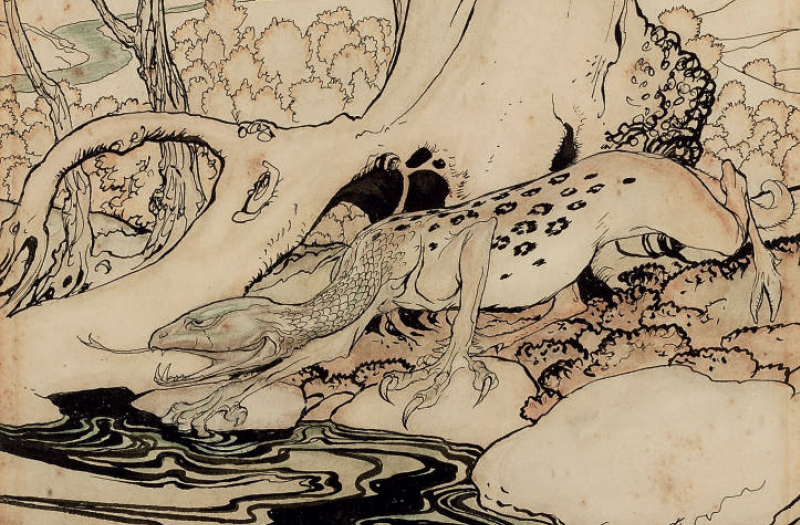Hark, thou televisual and cinematic executive knaves! Listen thee now to my just and true remonstrances. Thou art fools! Cads! Curs, I say! I have seen thy Sword in the Stone and thy “Knighty Knight Bugs,” thine accursèd Quest for Camelot and thy Black Cauldron, and even, I will have thee know, Merlin and the Dragons. ‘Tis true! So know thee now that I am aware of that of which I speak: thou hast gotten it all wrong! Thou hast not made ill films, per se—save Quest for Camelot, that truly wretchèd thing—but thou hast not done the tales of our glorious rex quondam rexque futurus, the beloved Arthur, justly and true! And what’s more, I ask thee: whither the Questing Beast!?
OK, that’s enough of that egregious, put-on Middle-ish English. Look, the Dot and Line has had many opinions on animation over the years, and they’ve all been good. Have we ever steered you wrong? Of course we haven’t! So when we say someone should animate something—like, say, The Godfather—someone better damn well listen. And I’m telling you now: give us an animated series about the Questing Beast and his greatest foe, the mighty Sir Palamedes.
“What the hell are you blathering about, Maher?” one might ask. Fair question! I’ll let the appendix of Keith Baines’s classic translation of Sir Thomas Malory‘s Le Morte d’Arthur answer it for you:
Sir Palomides (Palamedes) the Saracen: Son of King Asclabor. Brother to Sir Segwarydes (Segwarides) and half brother to Sir Safere (Safir). Unsuccessful rival to Sir Tristram (Tristan) as champion and lover of Queen Iseult (Isolde). Defeats the brothers Sir Helake and Sir Helyus at the Red City and is awarded suzerainty. Reconciled to Sir Tristram and baptized a Christian. Devotes himself to the pursuit of the Questing Beast, being next of kin to King Pellinore and successor to this task.
from the appendixes of Keith Baines’s translation of Sir Thomas Malory’s Le Morte d’Arthur
Now, you may remember King Pellinore from The Sword in the Stone, in which he was portrayed less than favorably as a bumbling old priss (somewhat similarly to his more gentle portrayal in T.H. White’s The Once and Future King, the film’s source material), but in Arthurian legend, the dude was a big deal. I mean, he was pretty shitty in Arthurian literature too, admittedly, but that’s because he had so many illegitimate kids, and not all of them consensually. That was the case with, like, half of everyone in Arthuriana, also. Chivalry, it turns out, didn’t actually mean being good to women? Anyway, moving on: Pellinore was a big freaking deal. For one thing, it was he—not his brothers, fellow kings Pelles and Alain—who was charged with his bloodline’s ancestral, theoretically perpetual quest of hunting the Questing Beast. (More on that in a minute.) For another, he was the father of, like, half of Arthur’s best knights, including Sir Lamerok (or Lamorak, who, in spite of his contemporary obscurity, was considered a lesser knight to only Lancelot and Galahad), Sir Torre (Tor), and Sir Percevale (Percival), who is one of only three knights to achieve the Holy Grail. (Pellinore is also eventually killed by Sir Gawain, King Arthur’s nephew and another of the greatest and best-known Knights of the Round Table, but that’s beside the point.)
How, then, was Palamedes, a Saracen (which is what Christian Europe used to call Arab Muslims), his next of kin? Look, all of this is mighty confusing because there’s a lot of begating and stuff involved, and honestly, I feel like Malory probably just donked this one up. Here’s the point: Palamedes was an extremely badass, deeply respected Arab Muslim knight. (Never mind the conversion to Christianity. That was kinda de rigueur for the Post-Vulgate Arthuriad, which was written even later than the Lancelot-Grail cycle, which came out once the Church in Rome was already so powerful that all the paganism-heavy chivalric romances of Chrétien de Troyes and Robert de Boron and their ilk didn’t cut it anymore. Plus, in prior tellings, he only converted on his deathbed. So.) And his prowess and valor were of such great note that he was charged by the great (relatively speaking) King Pellinore with upholding his ancestral quest for the Questing Beast.
“What the hell is the Questing Beast, Maher?” you may ask. Take it, Mr. Baines!
The Questing Beast: Has the head of a serpent, the body of a leopard, the buttocks of a lion, and the feet of a hart (deer). From its belly issues the sound of thirty pairs of yapping hounds. It is never brought to earth.
from the appendixes of Keith Baines’s translation of Sir Thomas Malory’s Le Morte d’Arthur
Except…it is! By Palamedes! Well, at least in some of the romances. There are lots of different tellings of this story because Arthuriana, bless its heart, is a tangled mess (I love it so) thanks to a whole bunch of institutional meddling, misinterpreted pseudo-historical texts, the multivarious perspectives of a whole slew of very different authors, and a bunch of other things that really, truly, no one needs me to rant about right now, including me. (Although if you ever want to read my college papers on how Sir Percival’s tale was remoulded again and again in order to fit each one of his authors’ politics and also on how Ralph Ellison’s The Invisible Man is a grail myth and its protagonist is basically Percival, I will gleefully send them to you, and you will regret it.) That said, in the Post-Vulgate Arthuriad, Palamedes converts to Christianity not on his deathbed but during the time the Knights of the Round Table are galavanting across England in search of the Holy Grail, and in so doing, he is released from his earthly entanglements or whatever. And in a scene for the ages, two of the Grail Knights and therefore two of the greatest knights who ever lived, Percival and Galahad, help him to trap the Questing Beast in a lake, where he finally slays something that by its very nature cannot be slain.
All of this is to say that if there were an animated series (preferably an anime) about a badass Arab Muslim knight in the era of King Arthur whose purpose in life is to chase a seemingly unconquerable beast bearing the head of a serpent, the body of a leopard, the buttocks of a lion, and the feet of a hart, from whose belly issues the sound of thirty pairs of yapping hound, abd who, whilst questing, commits various and sundry acts of derring-do and fights many a battle both alongside and against a number of the Knights of the Round Table, that animated series would be extremely awesome. Someone should make this show right now. (Netflix? You seem to love to throw around your money!) And if you need a head writer for it, I think you have all the proof you need that you’ve already found him.
Thanks for reading The Dot and Line, where we talk about animation of all kinds. Don’t forget to follow us on Twitter and sign up for our newsletter.





